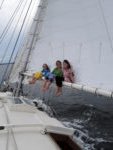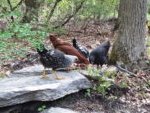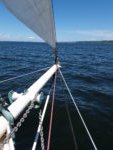

I had hoped, while writing the last blog post, that by the time I wrote this next one the whole corona crisis would be over, and we would be looking back on it as simply a wrinkle in our springtime. Perhaps we still will, one day, though more as a wrinkle in an entire season, if not year. In the meantime, while the landscape of lockdowns and restrictions ebbs and flows around us, our little family has at least found ways to not be idle.
The new house I mentioned in passing is on a decent-sized wooded lot, and long before the house was even built an ancient large garage had already begun to moulder into the landscape. That garage, of course, quickly became a shop—well, two, actually. While most of it is open space full of woodworking machinery from my favorite second-hand tool store, one small portion is walled off to keep it clean, and is the headquarters of Abednego Marine, my little rigging business.


The dirty shop, as we call the other portion, has seen empires of house materials come and go: stacks of baseboard, drywall, 2x4s, plywood, flooring, all absorbed into the house, a shed or two, and some henhouses—for you see, we are chicken farmers now as well. But with the house nearing completion, the shop is slowly morphing into its final and beautiful butterfly stage—that most wonderful of workspaces where boats take shape, nurtured from drawings traced upon the floor to bright-sided vessels bounding over the sparkling bay.

The first boat project we undertook was to build two more of the little experimental coracles I made several years ago. We’ve gotten a surprising amount of use out of the first one, which the children absolutely loved, and which now comes with us nearly every time we go sailing. The original plug had been sitting in a corner shedding plaster for over a year, so it was an easy matter to set it up and fair it over again with some leftover joint compound.
I made these two coracles with carbon fiber, and saved time by laying up two hulls in a row and then finishing them together. Each of the girls painted and named her own, and are now proud boat owners just like their dad. There is another boat project begun, and perhaps you’ve noticed it in one of the pictures–but that deserves a blog post of its own.


In the meantime, looking back at the last post, I can happily report that Ganymede’s renewed rigging is living up to my expectations of elegance and function, and we’ve been testing it out at least once a week. On our first anchor-out of the spring, with all the shiny new rigging glistening in the sun, my eye fell on the old and ancient sounding line, a piece of solid braid clothesline, stiff with age, that has told the depth without fail in hundreds and hundreds of harbors. I keep thinking that I ought to replace it, but truly cannot come up with a good reason why. It’s in no danger of breaking; my code of fathom marks is so familiar I can read them without thought, and the stiffness in the line keeps it from tangling too easily. I guess I’ll keep it as-is, for now, and focus on upgrading the other bits of rigging that are ready to be changed.
Even while I write this, the last coat of paint is drying on the two new coracles, and we’ll have them out for sea-trials next week. And with them out of the way, the dirty shop can now be devoted more fully to the next boatbuilding experiment, which you’ll have to wait to hear about until I can get around to writing next. And that may be sooner than expected, if this pandemic doesn’t let up soon.
Emily’s coracle is named “Coconut” The green paddle looks like a palm leaf. To me, at least.



